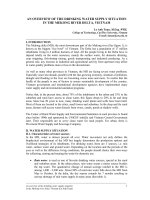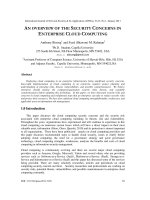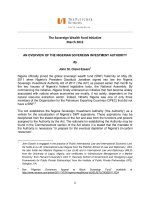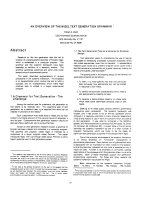ACCOUNTING SERVICES: AN OVERVIEW OF THE ACCOUNTING FUNCTIONS AT WESTERN MICHIGAN UNIVERSITY pdf
Bạn đang xem bản rút gọn của tài liệu. Xem và tải ngay bản đầy đủ của tài liệu tại đây (437.07 KB, 26 trang )
ACCOUNTING SERVICES
AN OVERVIEW OF THE ACCOUNTING FUNCTIONS AT
WESTERN MICHIGAN UNIVERSITY
Presented by:
Carrie Puckett, Senior Accountant
Lori Prichard, Assistant Director of Accounting Services
/>
ACCOUNTING SERVICES
A DIVISION OF BUSINESS & FINANCE
Accounts Receivable
Cashiering
Responsible to pay faculty, staff, and student payroll on a bi-weekly basis.
Issues annual W-2’s and other payroll forms and reports
Corporate Reporting and Taxation
Reconciles all University and Foundation bank accounts
Monitors and reconciles cash-vault balances
Payroll
Manages the University’s centralized cashiering systems
Oversees the e-commerce system for departmental stores and sales
Bank Reconciliations
Responsible for University billing and collections
Administers the University’s student payment plan and Perkins Loan program
Prepares the University and Foundation tax returns and other corporate reports
Provides advice to University departments in complying with current tax law
Plant Accounting
Responsible for recording and physically inventorying of capital assets
Manages the University debt.
2
GENERAL ACCOUNTING
Ensure the University’s financial transactions are reported accurately, completely, and in a
timely manner
Responsible for the financial reporting for the University as a whole
Provide monthly, quarterly, and annual financial reports
Responsible for the financial reporting systems, PeopleSoft and GLOW, and the on line
journal entry system (JES) for the University.
Assure compliance for federal, state, and all other accounting and audit principles and
standards as well as establishing policies and procedures for the University to adhere to
these standards
Responsible for the University’s annual external audit and the audited published financial
statements
Provide reporting for the State of Michigan and various other constituents
Provide accounting training and support to University departments
3
FISCAL YEAR VS. CALENDAR YEAR
Fiscal year refers to the timeframe a business or industry uses for
their financial recording
Some corporations/companies use the calendar year as their fiscal
year (January 1 – December 31)
Most universities and school districts use July 1 – June 30 as their
fiscal year
The State of Michigan uses October 1 – September 30 as their
fiscal year
4
ACCOUNTING PERIODS
An accounting period refers to a month in the fiscal year
Period 1 = July
Period 2 = August
Period 3 = September
Period 4 = October
Period 5 = November
Period 6 = December
Period 7 = January
Period 8 = February
Period 9 = March
Period 10 = April
Period 11 = May
Period 12 = June
Period 998 – Year-end adjusting entries for Accounting Services use only
Period 000 – Carry-forward totals from one year to the next
5
ACCOUNTING STRUCTURE
FUND
Department/Cost Center
Two digit number
Specific types
Seven digit number
This is the number that identifies your department
Where departments post revenues & expenditures
Account/Object code
Four digit number
Revenue, expense, asset, liability, and equity
Most commonly used by individual departments are revenue and expense
6
FUNDS
General Fund – 11
Designated Funds – 23
Designated Gifts – 24
Scholarships – 21
Grants – 25-30
Student Loan Fund – 31
Annuity and Life Income Fund – 32
Auxiliary Activities – 41 through 46
41 – Self-Liquidating
43 – Auxiliary other (Health
Center, West Hills)
44 – Bookstore
45 – Auditorium Operations
46 – Physical Plant
Agency and Trust – 51 and 52
WMU Research Foundation – 53
WMU Foundation – 54
Insurance and Benefits – 55
Paper Tech Foundation – 56
Plant funds – 61, 63-65
7
ACCOUNTS/OBJECT CODES
1xxx – Asset
2xxx – Asset (CIP – Construction in progress)
3xxx – Payroll expense
4xxx – Expenses other than payroll
6xxx – Liabilities
7xxx – Long-term Liabilities
8xxx – Revenues (income)
9xxx – Fund balance
Carry-forward account is 9200
Journals should never be posted against 9200
A complete list of accounts can be found on GLOW from the main page under “list accounts”.
8
ACCOUNTS
Assets
Liabilities
Something the university owns that has economic value
Can be tangible or intangible
Cash, accounts receivable, land
What the university owes
Accounts payable
Long-term debt
An example of an asset and a liability for most of us is our home and
mortgage. The home is our asset, the mortgage is our liability. The difference
is our equity.
9
ACCOUNTS
Expenses have a debit balance (3xxx, 4xxx)
Revenues have a credit balance (8xxx)
An expense is an outflow of the university’s cash
Supplies, advertising, salaries, memberships, interest expense
Revenue is an inflow of cash to the university
Tuition, course fees, sales, interest income
Monitoring account balances
Always be aware of the balances in your departments
If expenses are higher than revenues, this is a deficit
Deficits generally have to be funded by June 30 unless you have a special
exception
Accounting Services monitors for deficits in all funds other than fund 11 and
grants & contracts
10
JOURNAL ENTRY BASICS
Debit is positive / Credit is negative
Expenses have a debit balance / Revenues have a credit balance.
Think about what the journal needs to accomplish.
I have an expense in my department 23-0055000 that should be in my
department 23-0066000. How do I correct this?
The expense is showing up as follows:
23-0055000-4570 $65.72
The expense amount is a positive number
To move the expense, the following entry is needed:
23-0055000-4570 $-65.72
23-0066000-4570 $ 65.72
11
ACCOUNTING TRANSACTIONS
Example: I sent through a voucher to pay for supplies totaling
$249.00.
The transaction would be similar to a journal entry
The debit would be to your supply account (4570) for $249.00. You would
see the transaction and voucher number in your department detail
The credit would be to the university’s accounts payable for $-249.00
Once a check is produced, accounts payable is debited and cash is credited
for $249
Example: I received a check for $355.00, so I sent it to
cashiering for deposit.
If it’s a departmental deposit (versus an account payment, billed by
accounts receivable). The debit is to cash for $355.00.
The credit is to your revenue account (8980) for $-355.00. You would see
the transaction and IPAY number in your department detail.
12
JOURNALS AND OTHER TRANSACTIONS
Descriptions and Reference codes found in GLOW
IPAY at the end of a description = posted by cashiering for departmental
deposits
Generally only occur in revenue accounts
Will always be a credit (negative number)
Revenue from Accounts Receivable billing list WIN number, last name of
student, and the fee code.
Example of a voucher number: “V01062605”
Example of a purchase order: “P000025857”
Example of a journal entry: “I000219507”
Payroll transactions have a pay period included in the description such as
“R04” (pay period 4)
13
JOURNALS AND OTHER TRANSACTIONS
“ENDGTD” – Endowment distribution
“PP3549” – Physical Plant billings
“PROCARD” – Procurement card transactions/end of the month
“2063757 SEP10 TELECOM CHARGES” – T-com feed
“TRAVEL” – Transactions from the travel feed
Batches are reconciled when fed to the general ledger.
Journal errors must be corrected before they can post into the general ledger.
Always be aware of the transactions posted to your departments. Reconcile all
activity posted to your department.
14
TRANSFER/SUPPORT ACCOUNTS
4995/8995 is for transfers between funds (23 & 43)
4999/8999 is for transfers within the same fund (23 & 23)
These accounts should be used when a department is giving
“support” or “funding” to another department.
There is not necessarily a specific expense involved.
A department decides to contribute funds toward the expenses of another
department, perhaps for a special project.
In the case of an actual expense being reclassified, move the
entire expense amount and use the original account code.
15
EXAMPLE
The wrong department was charged.
GLOW showed that the Grad College incurred printing costs in
account 4482. Upon further investigation, you determined that
the charge belonged to Internal Audit.
The correcting journal entry is a debit to 4482 in Internal Audit
and a credit to 4482 in the Grad College.
16
EXAMPLE
Assistance is promised from a department’s fund 23 to a fund 11
for expenses incurred. A journal entry would be used to move
the funds.
The fund 23 is debited in 4995 and the fund 11 is credited in
8995.
The original expense remains in the fund 11
The debit to 4995 represents a transfer of funds out of the fund 23
(expense)
The credit to 8995 represents a transfer of funds into the fund 11 (revenue)
17
WMU DESIGNATED FUND 23 & 24 TRANSFER POLICY
Funds with no Limitations, Stipulations, or Donor Restrictions
Designated dollars in fund 23 or gifts in fund 24 that have no limitations or stipulations
placed on them by external agencies or donors may be used to support general fund
operations. Expenses can either be paid directly from the designated department/cost
center or transferred as support to a general fund operation to offset an operating deficit.
Funds with Limitations, Stipulations, or Donor Restrictions
For designated dollars in fund 23 or gifts in fund 24 received by the University for a
specific purpose or gifts that have donor restrictions, expenses related to those activities
should be paid directly out of the designated department/cost center. Specific examples
might be guest lecturers, travel abroad, or training where the funds were designated for
some specific intent on behalf of the donor.
Transfers from the General Fund (fund 11) to the Designated fund (fund 23 and 24)
department/cost center are not allowed unless otherwise approved on an exception basis
by the budget office or business and finance.
18
PREPAID EXPENSES
Payments for goods/services that span more than one fiscal year
Voucher/Invoice is paid up front, but expensed over the term of the
agreement
Accounts Payable uses “Prepaid Expense” account 1790 and journals the
appropriate portion of the expense each year
Example: Software license $180,000 for 2 year term
January 1, 2010 through December 31, 2011
Fiscal year 2010 (July 1, 2009 through June 30, 2010)
6 months of expenses (January through June)
$180,000 / 24 months = $7500 per month X 6 months = $45,000 in FY2010
Fiscal year 2011 (July 1, 2010 through June 30, 2011)
12 months of expenses
$90,000 in FY2011
Fiscal year 2012 (July 1, 2011 through June 30, 2012)
6 months of expenses (July through December)
$45,000 in FY2012
19
ALLOWABLE/DISALLOWABLE
TRANSACTIONS
May I transfer money from fund 11 to fund 23?
Only in specific circumstances.
You may if you determine that a specific expense has erroneously been
charged to the wrong department at which point the expense can be moved
between the two.
Generally fund 11 money has to be spent on fund 11 expenditures, you
wouldn’t transfer to other funds for other purposes
When may I deposit money into fund 24?
Fund 24 is designated gifts to the university. All gifts should always go
through the WMU Foundation, in-kind and cash. The Foundation transfers
gifts to the departments in August and February.
Gifts in-kind are gifts other than cash, such as goods or services.
The donor designates the university department .
Gifts to the university generally have a specific purpose and can only be used
for that purpose.
20
PLANT ACCOUNTING
Capitalize and physically inventory equipment costing more
than $5,000.
Software that is purchased or licensed and modified using more
than minimal incremental effort before being put into operation
should be capitalized if the amount exceeds $250,000
Software developed internally should be capitalized if the cost
of development and implementation exceeds $250,000
Capitalized equipment and software amounted to almost $70
million at June 30, 2010
21
PLANT ACCOUNTING
General ledger accounts for asset purchases necessary for
capitalization and or physical inventory:
4452 Computer Software
4850 Equipment over $5000
2xxx accounts are used for construction in progress. Construction and
remodeling projects over $25,000 have a department set up for tracking
purposes. These projects must have a funding source.
22
YEAR END CLOSE AND ROLLFORWARD
Fiscal year end is closed and amounts rolled forward after external auditors
complete annual audit of financial information (Late August or early
September)
The carryforward is the ending balance that rolls from the end of one fiscal
year to beginning of next fiscal year
Some departments keep balance intact from one year to the next, and this
amount is kept in account 9200
For other departments, balance gets swept clean at beginning of each fiscal
year
Scholarships, Designated, Student loan
Annuity and Life Income, some Auxiliary, Agency and Trust, Foundations, Insurance &
Benefits
General
Some Auxiliary
Other departments not closed – these are project to date
Grants
Plant
23
HELPFUL HINTS
JES to JEG process – due to federal grant requirements, any
journal entry that has a grant fund (25 – 30), requires the grants
and contracts department to approve this entry. Your journal
entry will post as a JEG versus JES.
Don’t forget to use the “post to prior period” option when
preparing a JES where applicable.
Moving payroll and related fringes – when a JES is used to
reclassify payroll expenses, any related fringe benefit account
is automatically adjusted.
24
ACCOUNTING SERVICES CONTACT AND
OTHER INFORMATION
Main Phone Line 387-4230
Located 1st floor Seibert Administration Building
Websites
Main />
Glow Users Guide />
JES Users Guide />
Accounts Receivable />
Corporate Reporting & Taxation />
Payroll />
25









